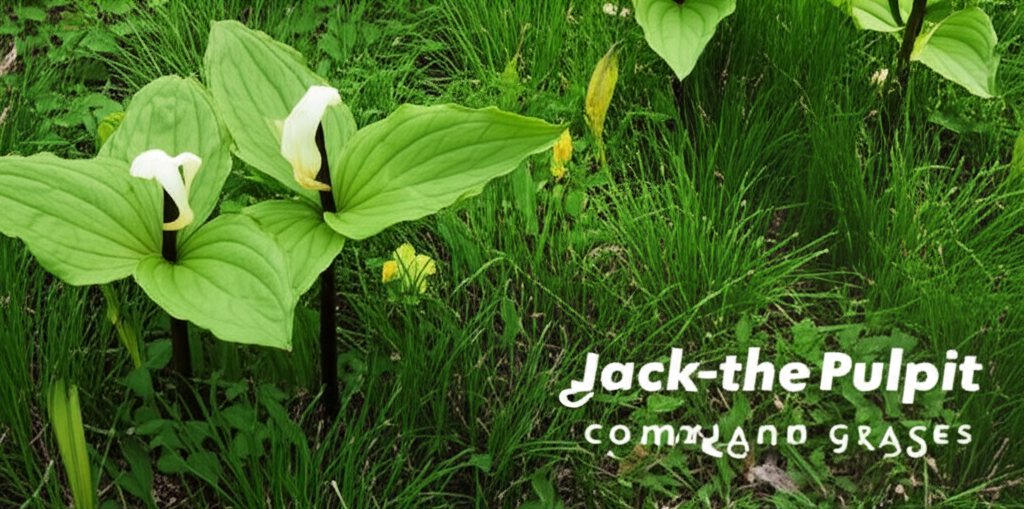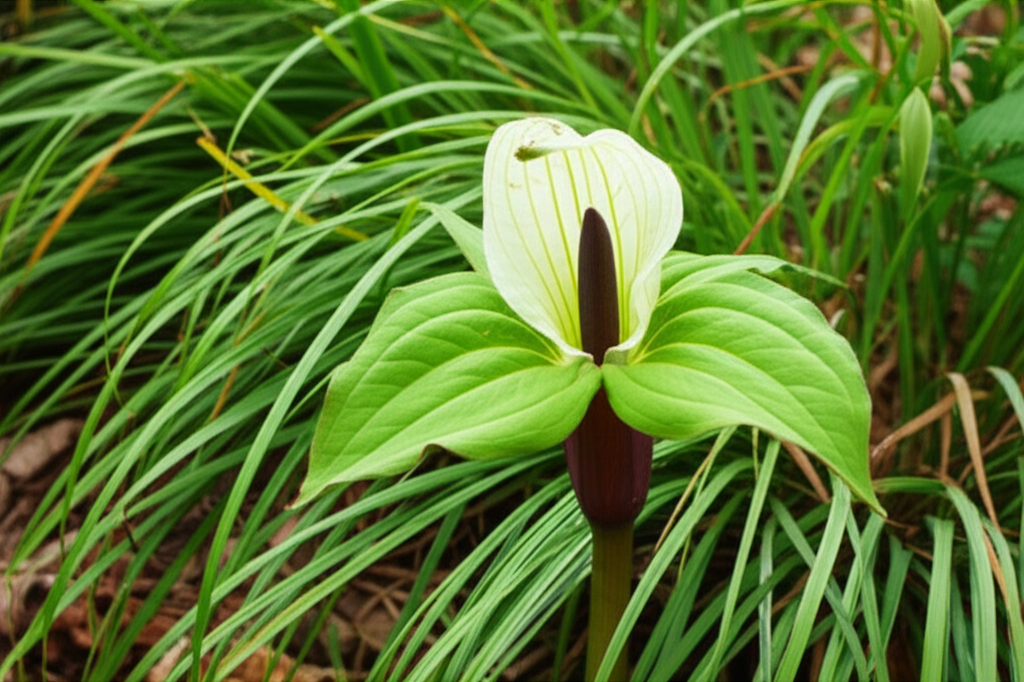The Enchanting Jack-in-the-Pulpit: A Woodland Jewel
The Jack-in-the-Pulpit, scientifically known as Arisaema triphyllum, is an iconic and fascinating native wildflower of North American woodlands. Its common name vividly describes its unique inflorescence: a hooded spathe (the “pulpit”) enclosing a club-like spadix (the “Jack”). This botanical marvel thrives in moist, humus-rich soils and dappled shade, often found carpeting forest floors alongside ferns and other woodland undergrowth.
Beyond its striking appearance, the Jack-in-the-Pulpit plays a vital role in its ecosystem. It provides a nectar source for early spring pollinators and its bright red berries, produced in late summer, are a food source for migrating birds. For gardeners seeking to recreate the magic of a woodland setting, understanding the Jack-in-the-Pulpit’s needs and how to best support its growth is paramount. This includes considering its ideal companion plants, particularly the often-overlooked but highly beneficial woodland grasses.
Why Companion Planting for Jack-in-the-Pulpit?

Companion planting is a horticultural technique that involves growing different plants in close proximity to enhance each other’s growth, health, and productivity. For the Jack-in-the-Pulpit, companion planting offers several significant advantages:
- Soil Health Improvement: Certain companion plants can help improve soil structure, aeration, and nutrient content, creating a more favorable environment for the Jack-in-the-Pulpit’s tuberous roots.
- Pest and Disease Management: Some plants may deter pests or attract beneficial insects that prey on common Jack-in-the-Pulpit nuisances.
- Moisture Retention: Groundcover companions can help retain soil moisture, which is crucial for the Jack-in-the-Pulpit, especially during drier periods.
- Weed Suppression: A well-chosen companion plant can outcompete weeds, reducing the need for manual weeding and preventing competition for resources.
- Aesthetic Enhancement: Companion plants can complement the Jack-in-the-Pulpit’s unique form and color, creating a more visually appealing and harmonious garden display.
- Habitat Creation: A diverse planting scheme can provide a more robust habitat for a wider range of beneficial wildlife.
The Underrated Charm of Woodland Grasses
While many gardeners focus on flowering companions for shade gardens, woodland grasses offer a subtle yet significant contribution to the ecosystem and aesthetic. These grasses are typically adapted to lower light conditions and share similar soil preferences with the Jack-in-the-Pulpit. Their architectural forms, varied textures, and seasonal interest add depth and dimension to what might otherwise be a sea of green.
Woodland grasses are often fine-textured, providing a delicate counterpoint to the bold structure of the Jack-in-the-Pulpit. Their foliage can range from vibrant green to subtle blues and bronzes, offering a dynamic visual appeal throughout the growing season and even into winter. Furthermore, their root systems can help stabilize the soil, preventing erosion in areas with a natural slope, and their foliage can provide winter cover for beneficial insects.
Key Facts and Comparison: Jack-in-the-Pulpit vs. Woodland Grasses
To understand the synergy between Jack-in-the-Pulpit and woodland grasses, it’s helpful to compare their key characteristics.
| Feature | Jack-in-the-Pulpit (Arisaema triphyllum) | Woodland Grasses (General Characteristics) |
|---|---|---|
| Light Requirements | Dappled shade to partial shade | Shade to partial shade |
| Soil Preferences | Moist, well-drained, humus-rich, slightly acidic to neutral | Moist to average, well-drained, humus-rich, adaptable |
| Mature Height | 1-3 feet | 1-4 feet (varies greatly by species) |
| Foliage Texture | Broad, trifoliate leaves | Fine to medium texture, linear leaves |
| Blooming Period | Late spring to early summer (spathe and spadix) | Late spring to fall (inflorescences/seed heads) |
| Key Visual Appeal | Unique “Jack-in-the-Pulpit” flower, bright red berries | Architectural form, varied foliage color and texture, airy seed heads |
| Native Range | Eastern North America | Widespread across North America |
This comparison highlights the natural compatibility between these plant types. Their shared preference for shade and moist, humus-rich soil makes them natural allies in the woodland garden.
Ideal Woodland Grass Companions for Jack-in-the-Pulpit
Selecting the right woodland grass species is crucial for creating a thriving and aesthetically pleasing planting. Here are some excellent choices that complement the Jack-in-the-Pulpit:
1. Pennsylvania Sedge (Carex pensylvanica)
This low-growing sedge is a quintessential woodland groundcover. It forms loose clumps of fine, arching, grass-like foliage that remains attractive throughout the year. Pennsylvania Sedge spreads slowly via rhizomes, creating a delicate carpet that suppresses weeds and retains moisture. Its subtle texture provides an ideal backdrop for the more dramatic bloom of the Jack-in-the-Pulpit.
2. Broadleaf Sedge (Carex plantaginea)
As the name suggests, this sedge features wider, glossy leaves than Pennsylvania Sedge. The foliage is often a beautiful deep green and has a slightly leathery texture. Broadleaf Sedge forms attractive, upright clumps and thrives in the same moist, shady conditions as the Jack-in-the-Pulpit. Its broader leaves offer a different textural element, creating visual contrast.
3. Wood Sedge (Carex woodii)
This sedge is known for its delicate, thread-like foliage that creates a soft, airy effect. Wood Sedge forms small, dense tussocks and is particularly well-suited for the understory of deciduous forests. It appreciates moist, well-drained soil and dappled shade, making it a perfect neighbor for the Jack-in-the-Pulpit, adding a fine-textured layer to the planting.
4. Bottlebrush Grass (Elymus hystrix)
Also known as Eastern Bottlebrush Grass, this native perennial grass is a striking addition to the woodland garden. It features upright stems topped with bristly, bottlebrush-like seed heads that provide excellent winter interest. Bottlebrush Grass tolerates a range of light conditions, from full shade to partial sun, and prefers moist, well-drained soil. Its upright habit and unique inflorescence offer a distinct architectural element.
5. Canada Wood-oats (Cinna arundinacea)
This graceful native grass forms open, airy clumps of arching foliage. Its most distinctive feature is its open, plume-like seed heads that appear in late summer and persist into fall, resembling oats. Canada Wood-oats thrives in moist, shady environments and can tolerate a variety of soil types, provided they are not too dry. Its delicate seed heads provide a soft, ethereal quality to the garden.
Steps to Companion Planting Success
Implementing companion planting effectively involves careful planning and execution. Here’s a guide to establishing a harmonious planting of Jack-in-the-Pulpit and woodland grasses:
| Step | Description | Pros | Cons |
|---|---|---|---|
| 1. Site Selection and Preparation | Choose a location with dappled shade and moist, well-drained soil. Amend the soil with compost or leaf mold to improve fertility and structure. Ensure the area is free of invasive weeds. | Establishes a healthy foundation for both plant types. | Requires initial effort in soil amendment. |
| 2. Planting Strategy | Plant Jack-in-the-Pulpit corms in fall or early spring, 2-4 inches deep. Space them according to their mature size. Plant woodland sedges and grasses around the Jack-in-the-Pulpit, allowing for their mature spread. Consider drifts or masses for a naturalistic look. | Promotes healthy root establishment and visual integration. | Requires understanding mature plant sizes for proper spacing. |
| 3. Mulching | Apply a layer of organic mulch (e.g., shredded leaves, pine straw) around the plants. Keep mulch a few inches away from the base of the Jack-in-the-Pulpit to prevent rot. | Retains soil moisture, suppresses weeds, regulates soil temperature, and enriches soil as it decomposes. | Can potentially smother small emerging seedlings if applied too thickly. |
| 4. Watering | Water regularly, especially during dry spells, to keep the soil consistently moist but not waterlogged. | Ensures the plants receive adequate hydration for optimal growth. | Overwatering can lead to root rot. |
| 5. Ongoing Maintenance | Remove any invasive weeds that appear. Trim back dead foliage in late winter or early spring before new growth emerges. Observe for any signs of pests or diseases and address them as needed. | Maintains the health and aesthetic appeal of the planting. | Requires ongoing observation and potential intervention. |
Aesthetic Considerations and Synergies
The beauty of companion planting lies in the subtle yet profound ways plants interact. When paired thoughtfully, Jack-in-the-Pulpit and woodland grasses create a dynamic and layered aesthetic.
The broad leaves of the Jack-in-the-Pulpit provide a bold focal point, while the fine textures of sedges and grasses offer a delicate contrast. The arching habit of species like Pennsylvania Sedge creates a softening effect around the more rigid structure of the Jack-in-the-Pulpit. As the seasons change, the visual interest continues. The ephemeral bloom of the Jack-in-the-Pulpit gives way to its striking red berries, while the grasses develop airy seed heads that add movement and texture.
In fall and winter, the dried foliage of both Jack-in-the-Pulpit and the grasses, along with the persistent berries, can offer subtle beauty and wildlife habitat. The subtle blues and greens of some sedges can provide a pleasing contrast to the browning foliage of deciduous trees, maintaining visual interest throughout the colder months.
Ecological Benefits of the Partnership
Beyond aesthetics, the combination of Jack-in-the-Pulpit and woodland grasses contributes to a healthier and more resilient woodland garden ecosystem.
- Improved Soil Structure: The diverse root systems of both plant types help to aerate the soil and prevent compaction, leading to better water infiltration and nutrient availability.
- Enhanced Biodiversity: A diverse planting scheme provides a wider range of food sources and habitat for beneficial insects, pollinators, and ground-dwelling creatures. The grasses can offer shelter for insects during the colder months, and their seed heads can be a food source for small birds.
- Reduced Erosion: The dense root networks of sedges and grasses help to bind the soil, preventing erosion, especially on slopes or in areas with increased rainfall.
- Nutrient Cycling: As the foliage of both plants decomposes, it returns essential nutrients to the soil, creating a closed-loop system that reduces the need for external fertilizers.
- Water Management: The groundcover provided by the grasses helps to retain moisture in the soil, reducing water runoff and improving water availability for the Jack-in-the-Pulpit.
Troubleshooting Common Issues
While this pairing is generally robust, a few common issues can arise, and understanding them can help prevent problems.
- Overwatering/Underwatering: Both plant types prefer consistently moist soil. Soggy conditions can lead to rot, while overly dry soil will stress the plants. Monitor soil moisture and adjust watering accordingly.
- Invasive Weeds: Weeds can outcompete young plants for resources. Regular weeding, especially in the first year, is crucial. Mulching significantly helps suppress weeds.
- Pests: While generally pest-resistant, Jack-in-the-Pulpit can occasionally be affected by slugs and snails, especially in very damp conditions. Beneficial insects attracted by the grasses may help keep some pest populations in check.
- Shade Levels: While they prefer shade, excessive deep shade can reduce the vigor of some woodland grasses and the flowering of the Jack-in-the-Pulpit. Ensure adequate dappled light reaches the planting area.
Conclusion: Cultivating a Woodland Oasis
The Jack-in-the-Pulpit, with its unique botanical charm, is a treasured native plant for any shade garden. By thoughtfully pairing it with the subtle beauty and ecological benefits of woodland grasses, gardeners can create a more vibrant, resilient, and harmonious woodland oasis. This symbiotic relationship not only enhances the aesthetic appeal of the garden but also fosters a healthier ecosystem, supporting a diverse array of plant and animal life. Embrace the natural affinity between these woodland dwellers and witness the creation of a truly captivating and ecologically sound garden space.
